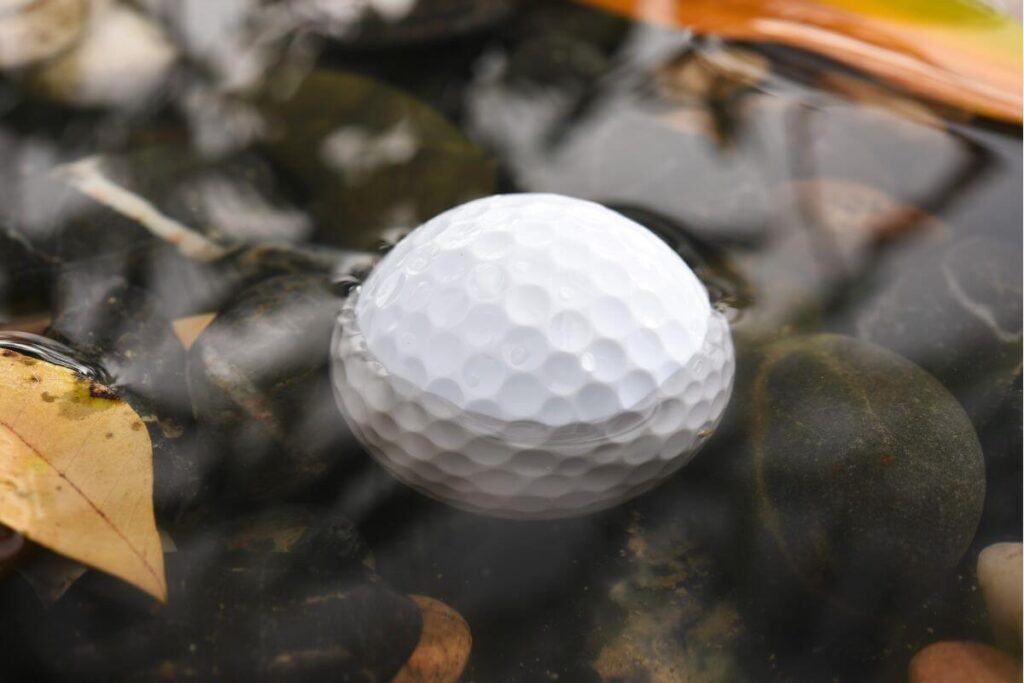Most balls in sports float, whether it’s a soccer ball, basketball, or even baseball. Now, what about golf balls?
When you play on a golf course with a pond or little pool obstacle, you can’t help but wonder, “Do golf balls float or sink?”
Generally speaking, golf balls do sink. Compare holding a golf ball with a tennis ball. You’ll notice the latter being much lighter, making it float. Meanwhile, golf balls hold a lot more mass, which heaves them underwater.
Stick around to learn more about the buoyancy level of golf balls, why most of them sink, and how you can potentially make them float.
Table of Contents
Why Do Golf Balls Sink?
Golf balls sink because they’re simply too dense. Whenever you hold the ball, you may already notice how relatively heavy it is for its size.
Its lack of floating ability can be scientifically explained. The density of water is measured at 0.58 ounces per cubic inch. On the other hand, golf balls weigh in at 0.65 ounces per cubic inch. With this in mind, golf balls are heavier than water, which allows them to sink underwater.
There’s one more reason why golf balls tend to sink. It mainly has to do with the ball’s surface area. Golf rules stipulate that golf balls need to be a certain size. Their diameter has to be around 1.68 inches.
This small surface area also contributes to its density, which makes it more likely to sink. To clarify, let’s consider another real-life example. When you’re in a swimming pool standing upright, your surface area touching the top of the water is much less than when you’re on your back, floating.
Since you’re more spread out, the less density you’ll carry when against the water’s surface, allowing you to float. That being so, you can’t exactly stretch a golf ball to compensate for its high density.
Why Do Golf Balls Float?
Although standard golf balls sink, there are still some that float. However, they’re not real golf balls. What we mean by that is that they’re not used professionally. Instead, you may find them in miniature golfing places.
These kinds of golf balls are hollow, making them lose all the compression inside, which vastly decreases their density.
Why Use Fake Golf Balls
They’re usually called fake golf balls. You may think, “Why would they use fake golf balls?” The answer is that the miniature golfing places just want to save money.
Fake golf balls are much cheaper since they come in large packages. Plus, the workers can easily snatch the floating balls from the water obstacles. Either way, it wouldn’t be too much of a loss if they lose one.
Another scenario where fake golf balls can come in handy is during practice. You can use these hollow balls to work on your swing, putting, and even get comfortable with a new golf club.
How to Make Golf Balls Float
You may have browsed the internet to search whether golf balls sink or float. You could’ve sworn you saw a video of a standard golf ball floating. Well, with the right conditions, you can make a real golf ball float and not just the hollow ones.
The trick is with changing the water’s density. There are several methods to increase water’s density. Some may include electrolyzing the water by adding more conductivity to the liquid through batteries and baking soda.
Another easier way to densify water is by adding salt. You can experiment by grabbing a bucket of water and placing your golf ball inside. Next, all you have to do is keep adding salt until the golf ball slowly rises and finally floats.
You can even see this demonstration in real life. When you try swimming in freshwater vs. seawater, it’s much easier to float on the latter due to the extra salt.
What Happens to Golf Balls When Left Underwater?
After understanding why standard golf balls sink, it’s time to look at what happens if they remain underwater. Should you retrieve it or leave it?
Well, golf balls and water aren’t the best combination. For one, a golf ball can absorb water. After the 12-hour mark, the liquid will begin to seep into the exterior urethane layer.
Then again, the time frame isn’t fixed. Some golf balls can last longer than others underwater, mostly depending on the outer layer. Those composed of durable resin can withstand a water shield for a longer time.
Other factors that affect the water absorption amount could be the temperature levels of the water the golf ball is submerged in. The warmer the water, the more susceptible the golf ball is to water absorption.
All the same, you wouldn’t be able to use a golf ball that’s been waterlogged for too long anyway. Water-damaged golf balls are usually rendered unusable since they’re grown in mass. The core expands after absorbing water and hits all the layers around it, making them weaker.
To exemplify this, if you use a 2 piece golf ball that’s been underwater for over eight days, the carry and roll of the ball can be reduced by up to six yards. In another case, a golf ball with more layers such as a 3-piece can lose about 12 yards if left for three months.
To Conclude
Do golf balls float or sink? As a general rule, golf balls are denser than water, making them sink. That’s not to say that some golf balls can’t achieve buoyancy.
Fake golf balls are hollow. This makes them less dense than water, rendering them floatable. Another factor worth considering is that you can make real golf balls float. You simply add salt to the water to increase its density.
To conclude, real golf balls sink. If you’re playing with your favorite golf ball, we recommend avoiding any water landscaping. That is unless you want to keep rummaging around the pond for the ball.



